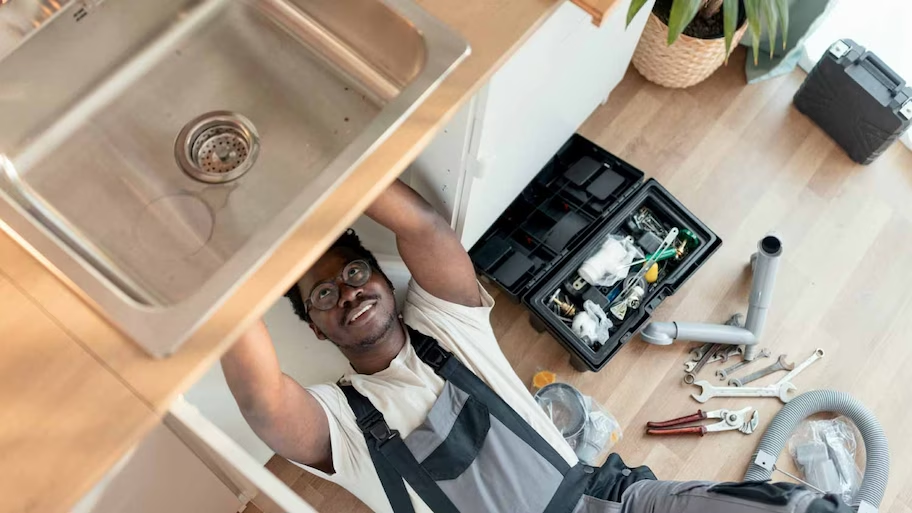Plumbing issues are inevitable for homeowners, but the good news is that most of them can be easily addressed with some basic knowledge and DIY skills. From clogged drains to leaky faucets, here’s a look at the top 10 common plumbing problems homeowners face and how to fix them.
1. Clogged Drains
One of the most common plumbing issues is a clogged drain. Over time, hair, soap scum, grease, and food particles can build up, causing a blockage in your sink, bathtub, or shower drain.
How to Fix It:
For minor clogs, use a plunger to try and clear the blockage. If that doesn’t work, try using a drain snake or a mixture of baking soda and vinegar. For stubborn clogs, it may be necessary to call a professional plumber to inspect the drainpipes.
2. Leaky Faucets
A dripping faucet is not just annoying; it can waste gallons of water each year. Most leaky faucets are caused by worn-out washers or seals inside the tap.
How to Fix It:
Turn off the water supply and disassemble the faucet. Replace any damaged washers or O-rings. Reassemble the faucet and turn the water back on to see if the leak has stopped.
3. Running Toilet
A running toilet wastes both water and money. This problem is typically caused by a faulty flapper, float, or fill valve.
How to Fix It:
Inspect the flapper valve and replace it if it’s worn out. Check the float level to ensure it’s not too high or low. If necessary, replace the fill valve. This simple fix can save you from unnecessary water bills.
4. Low Water Pressure
Low water pressure can be a result of clogged pipes, sediment build-up, or problems with the water supply line.
How to Fix It:
Check the aerator on your faucets to ensure it isn’t clogged with mineral deposits. If the problem persists throughout the house, you may need to call a plumber to inspect the pipes for blockages or leaks.
5. Leaky Pipes
Leaky pipes can lead to significant water damage and mold growth if left unaddressed. Leaks typically occur at pipe joints, around faucets, or from corrosion.
How to Fix It:
For minor leaks, use pipe tape or a pipe clamp as a temporary fix. For more serious leaks, you may need to replace a section of the pipe. If you’re unsure about the extent of the leak, it’s best to contact a professional plumber.
6. Water Heater Issues
A faulty water heater is a common problem, particularly in older systems. If your water heater isn’t producing enough hot water or is making strange noises, there’s likely an issue.
How to Fix It:
First, check the thermostat settings. If the temperature is too low, adjust it. If you notice strange noises, it could be sediment build-up, which can be cleaned by flushing the tank. If these fixes don’t work, consider replacing the heater.
7. Frozen Pipes
Frozen pipes can be a serious issue, especially during the winter months. When water inside pipes freezes, it expands and can cause the pipe to burst, leading to water damage.
How to Fix It:
To prevent frozen pipes, insulate any exposed pipes in unheated areas of your home. If a pipe does freeze, thaw it carefully using a hairdryer or heat tape. If the pipe has burst, turn off the water supply immediately and call a plumber.
8. Garbage Disposal Problems
A clogged or jammed garbage disposal can be a real inconvenience. Often, food debris gets stuck in the disposal, causing it to stop working properly.
How to Fix It:
Turn off the power to the disposal before attempting any repairs. If the disposal is jammed, use a wrench to turn the flywheel manually. Clear any debris and test the unit again. If the problem persists, the disposal may need to be replaced.
9. Sewer Line Issues
A blocked or damaged sewer line can cause unpleasant odors and backups in your home. Common causes of sewer line problems include tree root intrusion, grease buildup, or pipe collapse.
How to Fix It:
Sewer line problems typically require professional intervention. If you suspect an issue, don’t hesitate to call a plumber who can use a camera inspection to locate the problem and offer the appropriate solution.
10. Water Staining and Mold Growth
Water stains on walls, ceilings, or floors are often a sign of a leak. Over time, this can lead to mold and mildew growth, which poses health risks.
How to Fix It:
Identify the source of the leak, repair it, and replace any damaged drywall or flooring. Clean any visible mold with a mixture of water and bleach, and consider using a dehumidifier to prevent future mold growth.
Conclusion
Plumbing problems are part of homeownership, but many common issues can be fixed with a little DIY effort. Whether it’s a clogged drain, a leaky faucet, or low water pressure, understanding how to handle these problems can save you time, money, and hassle. However, for more complicated issues, don’t hesitate to call a professional plumber to ensure your plumbing system stays in good working condition.

